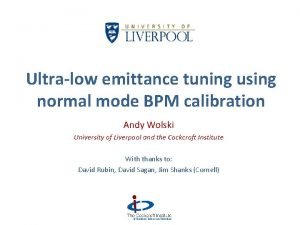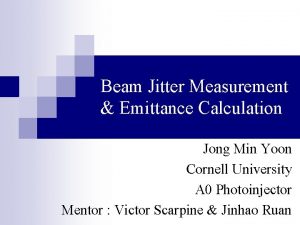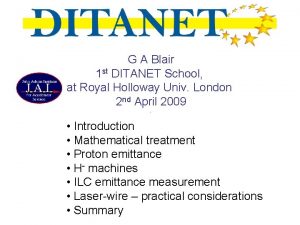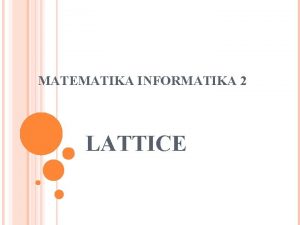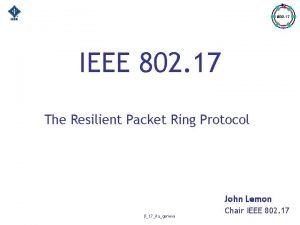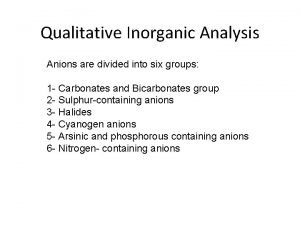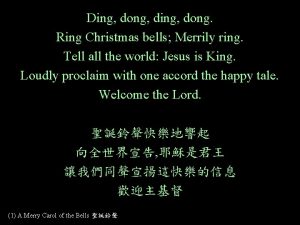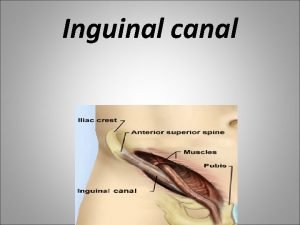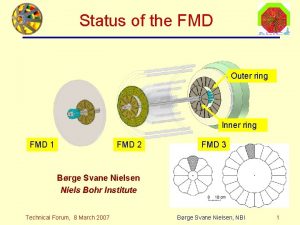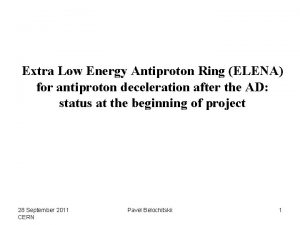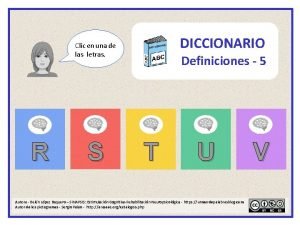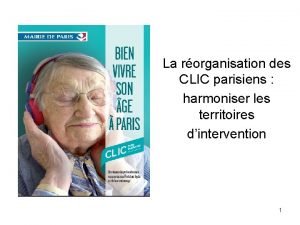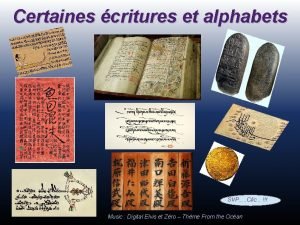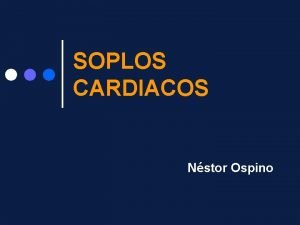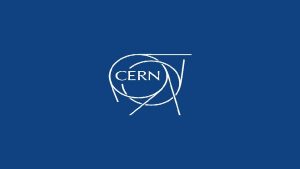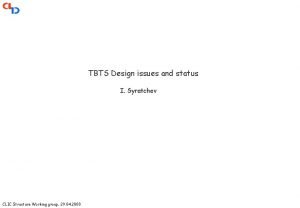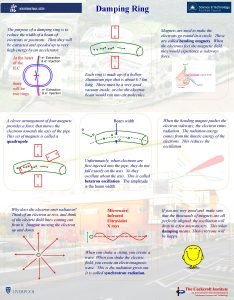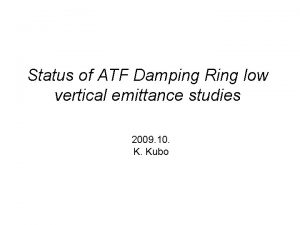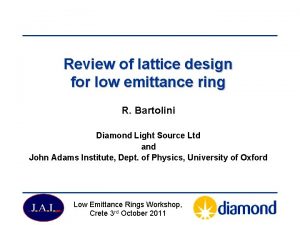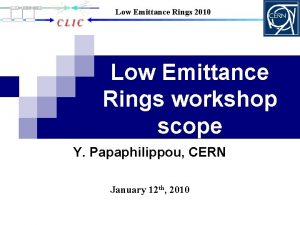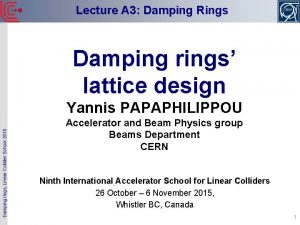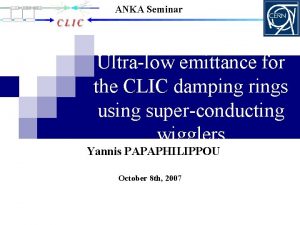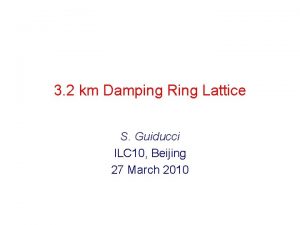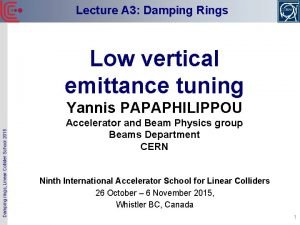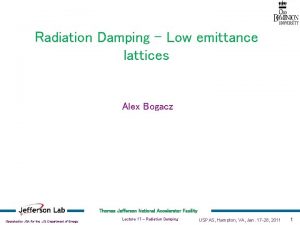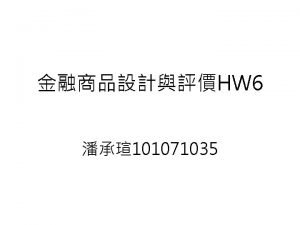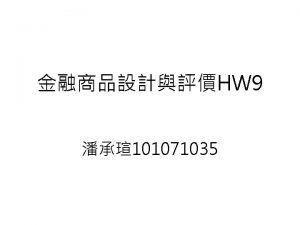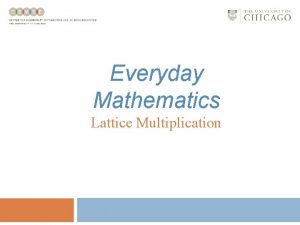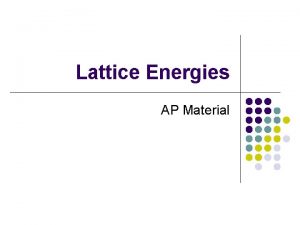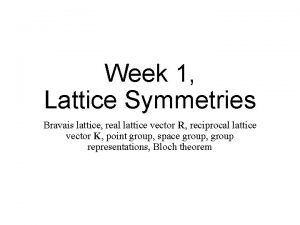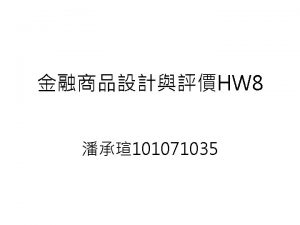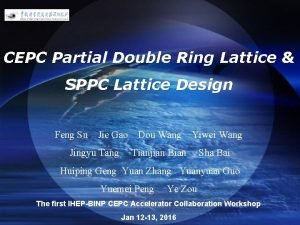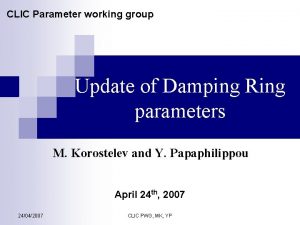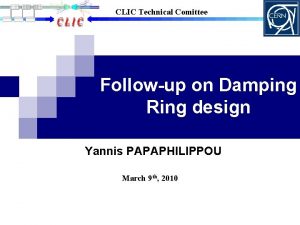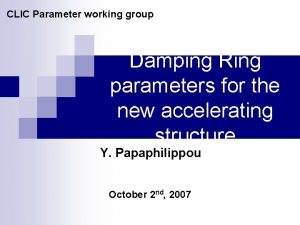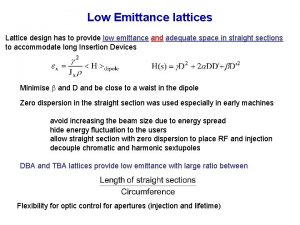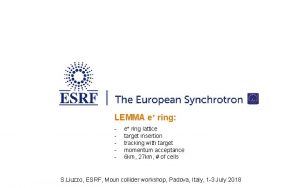Low emittance lattice for the CLIC damping ring





![Lattice versions compare Lattice Original V 06. 7 Energy [Ge. V] 2. 424 2. Lattice versions compare Lattice Original V 06. 7 Energy [Ge. V] 2. 424 2.](https://slidetodoc.com/presentation_image_h2/d72604e9d4e71c245a59c4368f4bbc1b/image-6.jpg)



![Arc cell evolution Original lattice: - Cell length, [m] Phase advance, x/y Natural chromaticity, Arc cell evolution Original lattice: - Cell length, [m] Phase advance, x/y Natural chromaticity,](https://slidetodoc.com/presentation_image_h2/d72604e9d4e71c245a59c4368f4bbc1b/image-10.jpg)




![IBS effect Bunch current [m. A] 0. 399 Bunch population 4. 10 E+09 Betatron IBS effect Bunch current [m. A] 0. 399 Bunch population 4. 10 E+09 Betatron](https://slidetodoc.com/presentation_image_h2/d72604e9d4e71c245a59c4368f4bbc1b/image-15.jpg)
![Main ring parameters Parameters Energy, Е [Ge. V] Circumference, Р [m] 2. 86 493. Main ring parameters Parameters Energy, Е [Ge. V] Circumference, Р [m] 2. 86 493.](https://slidetodoc.com/presentation_image_h2/d72604e9d4e71c245a59c4368f4bbc1b/image-16.jpg)









- Slides: 25

Low emittance lattice for the CLIC damping ring E. Levichev 1), Y. Papaphilippou 2), P. Piminov 1), S. Sinyatkin 1), P. Vobly 1), K. Zolotarev 1) 1) BINP, Novosibirsk 2) CERN, Geneva LER 2010, CERN, January 12 -14, 2010 1

Outline • • 2 Reasons for the CLIC DR lattice update CLIC DR lattice v 06. 7 Ring sections design and optimization Parameters without/with IBS Chromatic correction and dynamic aperture Preliminary magnets design Conclusion

Original lattice: main goals and parameters M. Korostelev, F. Zimmerman. Optimization of CLIC damping ring design parameters, Proc. of EPAC 2002, Paris, France, pp. 536 -538 M. Korostelev, Ph. D Thesis, CERN, 2006 • E = 2. 424 Ge. V (far from depolarizing resonances) • I = 150 m. A (bunch population is 4 x 109) • C = 360 m (very compact!) • Two arcs with 48 highly optimized TME cells in each (extremely strong quads and sexts!) • Two long straight sections with 38 damping wigglers in each. Total wiggler length is 2 sections x 38 w x 2 m = 152 m (lot of SR power radiated!) • Normalized horizontal emittance with IBS (very strong!) - 400 nm-rad 3

Damping wiggler parameters PMW emittance M. Korostelev: horizontal emittance with IBS as a function of wiggler field and period length Damping wigglers: PM SC (Nb. Ti) Period length cm 10 5 Aperture (beam) mm 12 12 Peak field T 1. 7 2. 5 W. length m 2 2 Temperature K Room 4. 2 K SCW emittance Only SC wigglers with low period length and high field amplitude can satisfy the CLIC DR requirements 4

Disadvantages of the original lattice Very compact lattice but no space between main magnets for correctors, BPMs, vacuum pumps and other equipments Strongly radiated damping wigglers but no room for SR absorbers Extremely strong quadrupoles and sextupoles can not be developed in the frame of today technology even for SC approach Poor separation of the vertical and horizontal betas in the arc TME cell provides problems with chromaticity correction and reduces the ring DA Very low vertical emittance induces strong space charge effects (the vertical tune shift >0. 1), which, together with external nonlinearities, degrade the beam distribution during damping A modification of the lattice with relaxed and realistic parameters but still satisfying the CLIC performance was needed! 5
![Lattice versions compare Lattice Original V 06 7 Energy Ge V 2 424 2 Lattice versions compare Lattice Original V 06. 7 Energy [Ge. V] 2. 424 2.](https://slidetodoc.com/presentation_image_h2/d72604e9d4e71c245a59c4368f4bbc1b/image-6.jpg)
Lattice versions compare Lattice Original V 06. 7 Energy [Ge. V] 2. 424 2. 86 Circumference [m] 365. 21 493. 02 493. 2 Length of the TME arc cell [m] 1. 73 2. 36 Betatron coupling [%] 0. 6 86/0. 5 148/0. 9 231/1. 4 1. 12× 10 -3 1. 09× 10 -3 465/2. 8 436/2. 6 487/2. 9 Energy spread (IBS) 1. 57× 10 -3 1. 56× 10 -3 1. 28× 10 -3 Bunch length [mm] 1. 32 1. 09 Longitudinal emittance [e. V×m] 5000 4000 RF voltage [MV] 4. 61 4. 68 6. 49 Energy acceptance 0. 015 0. 016 Natural chromaticity hor/ver -103 / -136 -149 / -79 -172 / -64 Radiation damping time hor/ver [ms] 1. 53 / 0. 76 1. 99 / 1. 01 1. 62 / 0. 82 0. 93 1. 27 1. 4 0 -8. 9 -10. 5 220 / -131 60. 3 / -34. 5 73. 4 / -42. 4 62 / -80 6. 3 / -6. 6 5. 0 / -5. 0 Norm. horizontal emittance (SR) hor/ver, [nm-rad] Energy spread (SR) Norm. horizontal emittance (IBS) hor/ver, [nm-rad] Bending field [T] Dipole focusing strength, G [T/m] Maximal quadrupole strength, G [T/m] Sextupole gradient [T/m 2]× 10 -3 6

CLIC DR requirements update Energy of 2. 86 Ge. V (the energy increase reduces the space charge effects and IBS) Beam intensity: 312 bunches x 4. 1 109 positrons (125 m. A current) Circumference less than 500 m (to accommodate all necessary equipment) 50 Hz repetition rate Normal conducting magnets with realizable parameters Normalized emittance: <500 nm (hor), <5 nm (vert), <5 ke. V-m (long) Wiggler sections sufficient for accommodation of SR power absorption system Large dynamic aperture 7

V 06. 7 general layout - Circumference 493. 2 m - Radius of arcs 37. 6 m - Length of straight section 114 m - Number of TME cells 96 + 4 - Number of SC wigglers 76 8

Arc cell design The arc cell is a TME design providing good separation of betas at chromatic sextupoles. For efficient chromaticity correction and sextupole strength reduction, the central quadrupole is split and the sextupole is placed in the hor. beta maximum. There is enough space between the magnets for BPMs, vacuum valves, flanges, pumps, etc. 9
![Arc cell evolution Original lattice Cell length m Phase advance xy Natural chromaticity Arc cell evolution Original lattice: - Cell length, [m] Phase advance, x/y Natural chromaticity,](https://slidetodoc.com/presentation_image_h2/d72604e9d4e71c245a59c4368f4bbc1b/image-10.jpg)
Arc cell evolution Original lattice: - Cell length, [m] Phase advance, x/y Natural chromaticity, x / y Length, m Maximal Strength Dipole 0. 54 0. 93 T Quadrupole 0. 16 220 T/m Sextupole 0. 07 / 0. 1 80 k. T/m^2 V 06 lattice: Cell length, [m] Phase advance, x/y Natural chromaticity, x / y 2. 3 0. 442 / 0. 045 -1. 25 / -0. 56 Length, m Strenght Dipole 0. 4 1. 27 T Quadrupole 0. 2 60 T/m Sextupole 0. 15 6. 6 k. T/m^2 V 06. 7 lattice: Cell length, [m] Phase advance, x/y Natural chromaticity, x / y 10 1. 729 0. 581 / 0. 247 -0. 85 / -1. 17 2. 36 0. 452 / 0. 056 -1. 51 / -0. 48 Length, m Strenght Dipole 0. 43 1. 4 T Quadrupole 0. 2 73. 4 T/m Sextupole 0. 15 5 k. T/m^2

Arc cell optimization Emittance w/o IBS Minimal emittance is: Emittance with IBS Chromaticity vs. phase advance w/o IBS for μx = 0. 46 μy → 0 with IBS for μx = 0. 47 μy → 0 For the IBS calculation the following parameters are taken: - Bunch population 4. 1 x 109; - Bunch length ~1 mm; - Hor. emittance (w/o IBS) 0. 181 nm*rad; 11

Wiggler cell design Wiggler cell is a dispersion free FODO with hor. beta optimized to reach the minimum emittance The space between the magnets (~0. 6 m) is enough to place SR absorbers, BPM, vacuum system equipment, etc. 12

Wiggler cell optimization Minimal emittance is: w/o IBS for μx = 0. 32 μy → 0 with IBS for μx = 0. 34 μy → 0 At IBS simulation it is taken into account parameters: Number of particles of bunch 4. 1 x 109 Longitudinal beam size 1. 0 mm Minimal hor. emittance (w/o IBS) 0. 027 nm*rad 13

Matching section - Matching section consists of dispersion suppressor, beta-matching and free straight sections for the RF, injection section and extraction section. - To increase dynamic aperture the unit matrix cell is created by 2 matching sections and straight section of regular FODO cells. 14
![IBS effect Bunch current m A 0 399 Bunch population 4 10 E09 Betatron IBS effect Bunch current [m. A] 0. 399 Bunch population 4. 10 E+09 Betatron](https://slidetodoc.com/presentation_image_h2/d72604e9d4e71c245a59c4368f4bbc1b/image-15.jpg)
IBS effect Bunch current [m. A] 0. 399 Bunch population 4. 10 E+09 Betatron coupling 0. 006 Without IBS Normalized hor. emittance, x [nm-rad] 231 Normalized ver. emittance, y [nm-rad] 1. 39 Energy spread, E/E 1. 089 Bunch length [mm] 0. 93 Longitudinal emittance [e. V m] 2890 With IBS Normalized emittance [nm-rad] 487 Normalized ver. emittance, y [nm-rad] 2. 9 Energy spread, 10 -3 1. 281 Bunch length [mm] 1. 09 Longitudinal emittance [e. V m] 4002 Ratio Em_ibs/Em_w/o_ibs 2. 10 Betatron coupling tuning fixes the longitudinal emittance at 4 ke. V*m. 15
![Main ring parameters Parameters Energy Е Ge V Circumference Р m 2 86 493 Main ring parameters Parameters Energy, Е [Ge. V] Circumference, Р [m] 2. 86 493.](https://slidetodoc.com/presentation_image_h2/d72604e9d4e71c245a59c4368f4bbc1b/image-16.jpg)
Main ring parameters Parameters Energy, Е [Ge. V] Circumference, Р [m] 2. 86 493. 16 Bunch population (109) 4. 1 Coupling, [%] 0. 6 Energy loss per turn, U 0 [Me. V] 5. 75 Dumping time x/y/s [ms] RF voltage, URF [MV] RF frequence, GHz 16 V 06. 7 1. 62/ 1. 64 /0. 82 6. 49 2 RF harmonic, h 3289 Energy acceptance, E/E 0. 016 Natural chromaticity, x/ z -172 / -64 Compaction factor, 6. 49 E-05 Damping radiation integral, I 2 [1/m] 6. 10 Excitation radiation integral, I 5 [1/m] 2. 14 E-05 Number of arc cells, Nc 100 Number of damping wigglers, Nw 76 Normalized emittance, x [nm-rad] 231 Energy spread, E/E 1. 089 Bunch length [mm] 0. 93 Longitudinal emittance [e. V m] 2890

Strategy for DA optimization Main source of the dynamic aperture limitation is strong chromatic sextupoles in the arcs. The wiggler nonlinearities are small. To optimize the DA the following strategy was applied: - Rejection of the original interleaved sextupole (comment at the next slide) - Arrangement of simple and effective sextupole families (SF, SD) with well separated betatron functions - Minimizing of the arc cell chromaticity - Adjusting of the phase advance for a single cell to achieve required emittance together with the maximum DA - Constructing of two-arc ring; optimum DA for the single cell will be also optimum for the whole ring -Adjustment for the wiggler section unit matrix in both transverse directions 17

Comment of the interleaved sextupoles SF SD –I –I Non-interleaved sextupoles cancel all orders of nonlinear aberrations –I –I Interleaved sextupoles cancel only second order aberrations but produces higher orders, which can reduce dynamic aperture drastically. 18

Arc cell aperture optimization Horizontal Vertical DA vs betatron tune advance for the arc cell. Color indicates the DA size (red is for the large and blue is for the small size). Black point shows the tune before optimization; arrows shows a direction of the tune change to increase the aperture. 19

DA comparison V 06 Original 4 D DA for the whole ring in terms of injection sigmas (hor x ver): Original: 3 x 8 V 06: 10 x 48 V 06. 7: 23 x 142 20 V 06. 7

Main magnetic elements Element No Length, m Max. Strength Dipole 102 0. 43 1. 4 T Quadrupole 492 0. 2 73. 4 T/m Sextupole 296 0. 15 5 k. T/m 2 Wiggler 76 2 2. 5 T All normal conducting magnets are made of laminated iron in usual technology. For the sextupole an alternative design with permanent magnet concentrator and increased sextupole strength is proposed. 21

Quadrupole preliminary design Magnetic induction distribution Ampere turns 2. 5 к. А×turns Overall length 23 cm Inscribed radius 12 mm Gradient 22 2 D Fourier analysis of quadrupole ~ 7. 5 k. Gs/cm

Sextupole preliminary design Magnetic induction distribution 2 D Fourier analysis of sextupole Ampere turns 2. 5 к. А×turns Overall length 13 cm Inscribed radius 12 mm Sextupole strength 23 ~ 5 k. Gs/cm 2

Sextupole with permanent magnet concentrator Magnetic induction distribution Ampere turns 4. 5 к. А×turns Overall length 13 cm Inscribed radius 12 mm Sextupole strength 24 2 D Fourier analysis of sextupole ~ 7. 5 k. Gs/cm 2

Conclusion v The CLIC DR lattice v 06. 7 with realistic parameters is designed. The lattice performance satisfies the damping requirements v The dynamic aperture of the v 06. 7 lattice is optimized. The size of the DA seems quite enough for reliable machine operation v Preliminary design of the normal conducting quadrupole and sextupole magnets is considered v BINP is ready to participate in the CLIC DR design report preparation 25
 Emittance
Emittance Emittance
Emittance Linac22
Linac22 Contoh lattice
Contoh lattice Resilient packet ring
Resilient packet ring Analysis of anions
Analysis of anions Ding dong ding dong christmas bells are ringing
Ding dong ding dong christmas bells are ringing Ring uterus
Ring uterus Ring christmas bells ring them loud
Ring christmas bells ring them loud Inguinal canal 3d model
Inguinal canal 3d model Inner ring and outer ring
Inner ring and outer ring Ball valve mechanism of inguinal canal
Ball valve mechanism of inguinal canal Low energy antiproton ring
Low energy antiproton ring Low voltage = low hazard
Low voltage = low hazard Mid low high
Mid low high Low accuracy low precision
Low accuracy low precision Emotive style communication
Emotive style communication Objetos con la letra v
Objetos con la letra v Clic paris emeraude
Clic paris emeraude Alphabet protocananéen
Alphabet protocananéen Clic
Clic Dead clic
Dead clic Soplos mesosistolicos
Soplos mesosistolicos Son clochette saint nicolas
Son clochette saint nicolas Rey orozco
Rey orozco Cern clic
Cern clic
